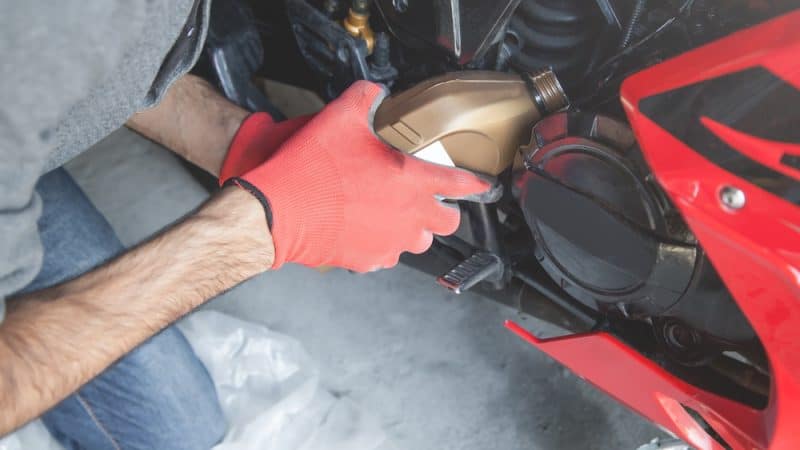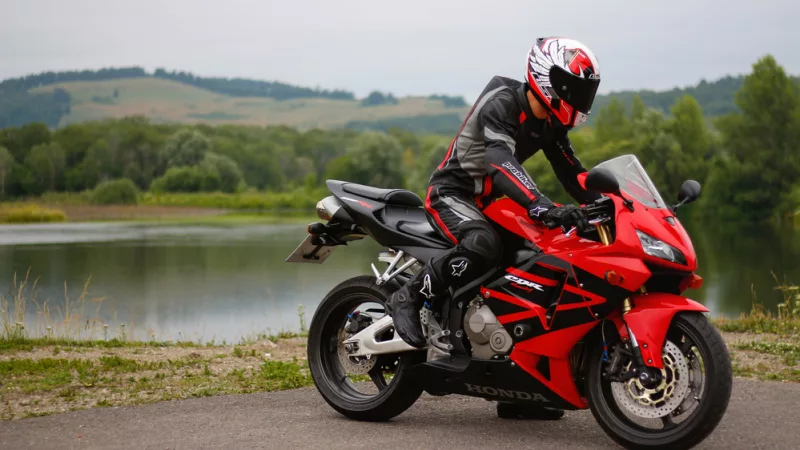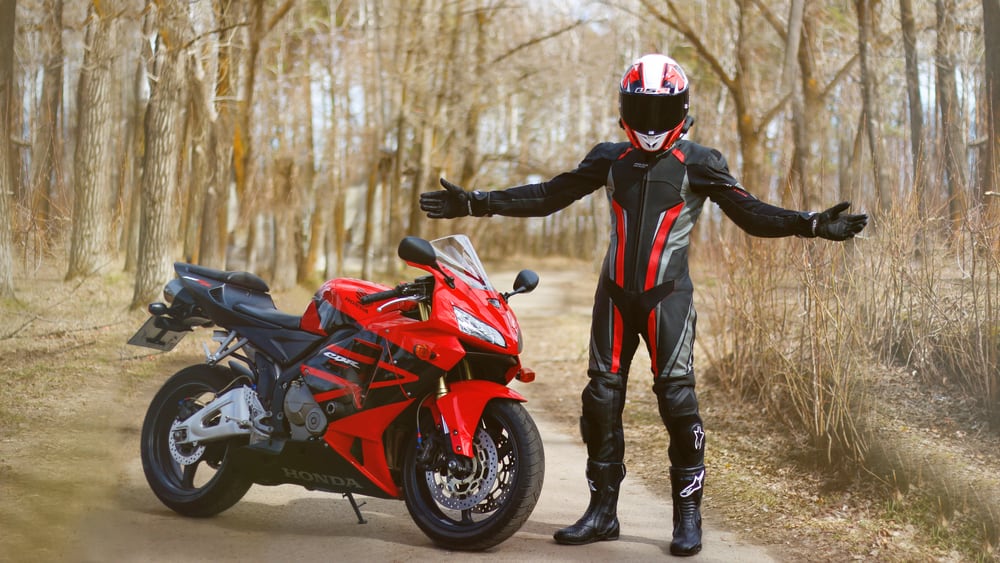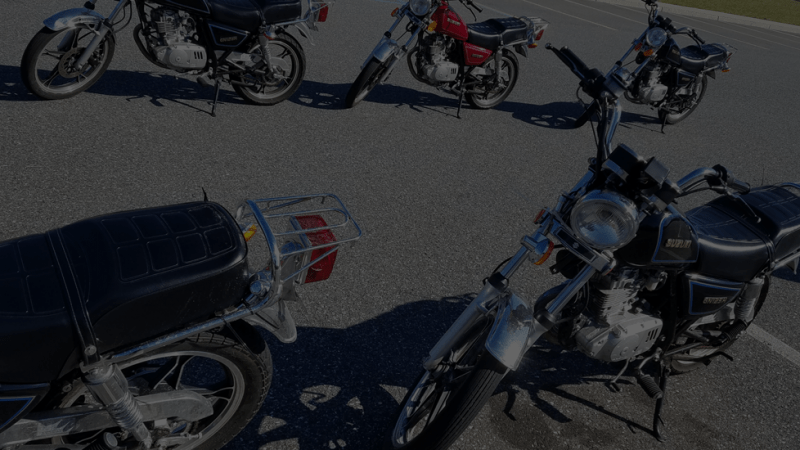Starting a motorcycle is easier than it used to be, thanks to technology. While there are various kinds of bikes, starting a Yamaha R6 or other fuel-injected motorcycles is more or less then same across the board.
Here is how you start a fuel-injected motorcycle, like the Yamaha R6:

Starting The Engine of a Yamaha R6
You can find this information in the owner’s manual of your bike, too. Before starting the bike, make sure you have done the following:
- The transmission is in neutral.
- The transmission is in gear, the clutch is pulled, and the kickstand/sidestand is stowed. Some modern models, Yamaha included, have a safety feature that will prevent the bike from starting if the sidestand hasn’t been raised.
Next, follow these steps precisely:
- Insert the key into the ignition.
- Turn the key to the ON position. Make sure the engine stop switch is set to the correct position.
- Warning lights and indicator lights should illuminate momentarily then disappear if conditions are satisfactory. These lights include:
- Oil level
- Coolant temperature
- Fuel level
- Shift timing
- Engine problems
- Immobilizer system
- Shift the transmission into neutral. The light should come on. If not, you might have an electrical circuit problem.
- Start the engine with the start switch.
- In the event of failure, wait a few seconds and try another start. Don’t draw out the time trying to start the engine to preserve battery power. Do not extend for more than 10 seconds.
General Instructions for a Fuel-Injected Motorcycle
Here’s some instructions to follow if you don’t have the make/model mentioned above:
How To Start A Motorcycle
- Put the motorcycle in neutral. Neutral is always located between 1st and 2nd gear.
- Put the key in the ignition if necessary.
* Note: Fuel-injected motorcycles have an engine management system. This means you don’t have to worry about using the choke lever. Only a small amount of throttle will be needed, regardless of engine temperature. - Start pulling the clutch near the left handlebar. Some riders choose to pull the clutch and front brake simultaneously, but the choice is yours.
- Press and hold the start button. You will find this on the right handlebar. Maintain your hold on the clutch.
- The motorcycle should automatically catch and start.
- If the engine doesn’t turn over and start immediately, you can try using the throttle while pressing the start button. Make sure you are holding the clutch.
- Remember to never crank the engine for more than 10 seconds clips at a time. Otherwise, you’re wasting battery power.
- You can slowly start to release the clutch.
Now, you’re ready to ride!
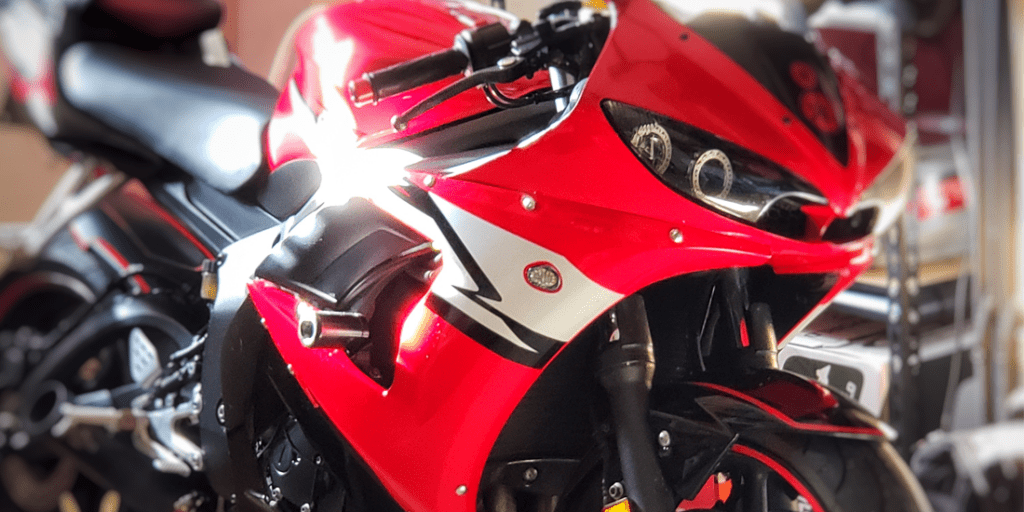
Final Thoughts
Unlike carburetor motors, fuel injection systems rarely fail. To prevent the pump from failing, do some routine maintenance. Get into the habit of listening to the bike and know what a healthy running engine sounds like. That way, if something unusual happens, you will be able to tell whether or not something is wrong with the pump fuse by sound alone.
Modern fuel-injected motorcycles are easy to start. Follow the instructions in this article, and you will have no problem.
For more information about how to start, ride, and care for your motorcycle, check out my YouTube channel. Hit the subscribe button for notifications whenever there’s an update.
You Might also like
-
How Often Do I Need To Change Motorcycle Engine Oil?
Changing engine oil is essential to maintaining the life of your beloved motorcycle. If you don’t consistently check the oil level and change the oil when it gets old or dirty, the lifespan of the motor is severely shortened.
Let’s get started.How Often You Need To Change Motorcycle Oil
Most riders will ask the question, “How often do I need to change the motorcycle engine oil?” at least once. The answer depends on the make/model of your bike (we’ll be discussed a Yamaha YZF-R6), the type of oil you used, and how often you ride.
If you used a mineral-based engine oil (the simplest, cheapest kind), then you should change the engine every 2,000 miles if you’re riding frequently. If you don’t ride regularly, you can change your oil at least twice a year.
When using a semi-synthetic engine oil, change the oil once every 5,000-6,000 miles.
Lastly, if you use a fully-synthetic engine oil, change the oil after 7,000-10,000 miles.
Semi- and fully-synthetic motor oils are more expensive than mineral-based engine oil, but the plus side is that they last much longer. The only time when you might have to change before the recommended mileage, regardless of the motor oil type, is if you are riding your bike every single day or you commute a great distance frequently.Yamaha YZF-R6 Oil Change Instructions
You can find the following information in the owner’s manual of your Yamaha YZF-R6. If you don’t have this specific Yamaha model, it’s recommended you find the specific instructions for your make and model, as the steps could be different.
- Checking the engine oil level:
- Put the motorcycle on a level surface and hold it in an upright position, as straight as possible. Slight tilts could result in a false read.
- Start the engine. Let the oil warm up for several minutes.
- Turn the motorcycle off again.
- Wait for the oil to settle. This may take a few minutes.
- Remove the engine oil dipstick. Wipe it clean with a cloth then insert the stick back into the fuel reservoir. Take a moment to look at the maximum and minimum oil level lines before testing if you’re not familiar with it. Don’t screw the stick in. Remove it again to get your reading.
- If the engine oil level is at or below the minimum level, remove the engine filler cap and add a sufficient amount of oil to get the level to the recommended spot.
- Insert then tighten the engine oil dipstick. Afterwards, install and tighten the oil filler cap.
During this stage of your oil check, you might find that you need to change the oil completely.
How To Tell If You Need An Oil Change
The normal color of oil is transparent, brownish, maybe even slightly black. When oil is “clean,” it works best for protecting and keeping the engine clean.
Now, “dirty” oil is when the water consistency is lost. It feels slightly gritty when rubbed between your fingers. The color will be darker, if not completely black, and it will have lost it’s transparency.
You might also notice that the engine is making bizarre noises when the oil is dirty. All these signs point to needing an oil change.
How to change engine oil on a Yamaha YZF-R6:
- Put the motorcycle on a level surface.
- Removing the cowling.
- Start the engine for several minutes. Once warmed, turn the bike off.
- Place an oil pan under the engine to collect used oil.
- Remove the engine oil filler cap, the engine oil drain bolt, and lastly the gasket to drain the oil from the crankcase.
- Once the oil is drained completely, replace the gasket and bolt, fill the tank to the recommended level, and then replace the engine oil filler cap.
When To Change The Oil Filter
Change the filter every time you change the oil or once every 2,000 to 3,000 miles if you’re using synthetic motor oil. You don’t want to ride around with a dirty, old oil filter because it traps any dirt, dust, debris, metal, and sludge that would otherwise harm your engine.
Not a frequent rider? Again, change your oil at least twice a year and pair that with a filter change.Conclusion
To wrap everything up, frequent riders will need to change their oil more often than those who ride once in a while. The quality of the motor oil changes the mileage for oil changes, and synthetic oils will have the longest life. Make sure to check the oil level and consistency often so you can protect the engine and preserve the life of your ride.
Enjoyed this information and want more? Head over to my YouTube channel. Subscribe and receive notifications for every update. -
The Thrill of Speed vs. Reality: Can You Live with a Superbike as a Daily Driver?
Speed Demons for Everyday Riders? Exploring the Practicalities of Owning a Superbike
The roar of the engine, the wind whipping past your helmet, and a blur of scenery – the allure of a superbike’s exhilarating speed is undeniable. But for many riders, the question arises: can you live with a superbike as a daily driver? This article delves into the thrilling reality of owning a superbike for everyday use, exploring both the exhilarating aspects and the practical challenges.
Key Takeaways
- Superbikes offer exhilarating speed and unforgettable experiences, but come with challenges like lower fuel efficiency, less comfort, higher maintenance costs, and reduced maneuverability compared to standard motorcycles.
- Consider individual needs and preferences before deciding if a superbike is suitable for daily driving.
- Explore alternatives like sport touring models or used superbikes for a balance between performance and practicality.
- Prioritize safety and experience to ensure responsible and enjoyable riding.
Comparison Table: Superbike vs. Standard Motorcycle for Daily Use
Feature Superbike Standard Motorcycle Performance High Moderate Fuel Efficiency Low Moderate to High Comfort Low Moderate to High Maintenance Costs High Moderate Maneuverability Low High Comparison Table: Superbike vs. Standard Motorcycle for Daily Use
The Allure of Speed:
Superbikes, also known as fastest production motorcycles or fastest sportbikes, boast incredible top speeds and lightning-fast acceleration. These machines are the pinnacle of engineering, pushing the boundaries of performance and embodying the thrill of the ride. For many riders, owning a superbike fulfills a lifelong dream, offering an unmatched experience on the open road.
The Practical Realities:
However, the reality of owning a superbike for everyday use can be quite different from the initial excitement. Here are some key factors to consider:
- Fuel Efficiency: Superbikes are notorious for their fuel-thirsty nature. Their high-performance engines often translate to lower fuel economy compared to standard motorcycles. This can be a significant financial consideration, especially with rising fuel costs.
- Comfort: Superbikes are designed for performance, not comfort. Aggressive riding positions with low handlebars and rearset footpegs can lead to fatigue and discomfort on longer rides. Additionally, the lack of wind protection can be unpleasant, particularly in harsh weather conditions.
- Maintenance Costs: High-performance machines often come with higher maintenance costs. Regular servicing, including frequent tire changes and specialized parts, can be more expensive than with standard motorcycles.
- Maneuverability: Superbikes are designed for speed and handling on racetracks, not navigating city streets. Their larger size and heavier weight can make them less maneuverable in tight spaces and stop-and-go traffic.
Beyond the Numbers:
While these practical considerations can be daunting, it’s important to remember that owning a superbike is not just about the numbers on a spec sheet. It’s about the emotional connection you have with the machine, the sense of freedom it offers, and the unforgettable experiences it creates.
Finding the Balance:
Ultimately, the decision of whether or not a superbike is suitable for daily driving comes down to individual needs and preferences. If you prioritize fuel efficiency, comfort, and practicality, a standard motorcycle or a sport touring model might be a better fit. However, if you’re willing to embrace the challenges and embrace the thrill of owning the fastest street-legal motorcycle, a superbike can be a rewarding experience.
Additional Considerations:
- Alternatives: Consider exploring the fastest-liter bike 2023 options that offer better fuel efficiency and comfort while still retaining some of the performance characteristics.
- Used Superbikes: Purchasing a used superbike can be a cost-effective option, allowing you to experience the thrill without breaking the bank.
- Riding Experience: Ensure you have the necessary skills and experience to handle the power and performance of a superbike before making a purchase.
6 FAQs About Superbikes as Daily Drivers
6 FAQs About Superbikes as Daily Drivers
1. Are superbikes good for commuting?
Superbikes can be challenging for daily commutes due to lower fuel efficiency, less comfort, and potential difficulties in stop-and-go traffic. Consider alternative options like sport touring models for better practicality.
2. How much does it cost to maintain a superbike?
Superbikes generally have higher maintenance costs due to frequent servicing, specialized parts, and high-performance tires.
3. Can you make a superbike more comfortable for daily use?
While limited, some aftermarket accessories like handlebar risers and windshields can slightly improve comfort on longer rides.
4. What are some alternatives to superbikes for daily driving?
Sport touring models offer a good balance between performance and comfort, making them suitable for both spirited riding and everyday commutes.
5. Is it dangerous to ride a superbike as a daily driver?
Superbikes require a higher level of skill and experience due to their powerful engines and aggressive handling. Ensure you have adequate training and practice before riding one regularly.
6. What’s the best way to decide if a superbike is right for me?
Carefully assess your needs, priorities, and riding experience. Consider taking test rides on different bike types before making a decision.
Facts & Statistics: Superbike Market and Daily Riding
- The global superbike market size was valued at USD 5.2 billion in 2022 and is expected to grow at a CAGR of 4.1% from 2023 to 2030. (https://www.grandviewresearch.com/industry-analysis/motercycles-market-report)
- Only 20% of motorcycle owners commute to work on their bikes regularly in the United States. (https://msf-usa.org/)
- Comfort and fuel efficiency are two of the most important factors considered by motorcycle buyers when choosing a motorcycle for daily use. (https://powersportsbusiness.com/news/2023/08/03/mic-motorcycle-segment-up-through-q2/)
By carefully weighing the pros and cons, and considering alternative options, you can make an informed decision that aligns with your riding style and lifestyle. Remember, the fastest motorcycle on the market isn’t always the best fit for every rider. Choose a bike that allows you to experience the joy of riding, be it a superbike in occasional bursts or a more practical option for everyday use.
-
What to Expect at a Beginner Rider Course
If you want to gain valuable experience, then you go to school. The same applies to motorcycle riding. When you sign up for the Beginner or Basic Rider courses that are available from multiple organizations throughout the U.S., you are taking a giant step forward. Here is what to expect:
Pre-Course Assignment
The assignment that you receive is dependent on the organization that you sign up with. Make sure you do this work, because you will be better prepared for what is to come in the class. You are welcome to take notes, write down questions to ask the instructor, and familiarize yourself with the terminology.
Necessary Items
When you have class, you should bring your student handbook, a notepad, pen, and some food items for snacks and lunch. These classes will last for most of the day, so be prepared for a full day of learning and moving.
You should wear jeans with ankle boots, a long-sleeved shirt or jacket, full fingered gloves, and a DOT-legal helmet. Some schools will have helmets to borrow if you don’t have one. Keep in mind that you won’t be able to attend the class if you don’t have the appropriate gear.
Also, regardless of the weather, the class will go on. Be prepared for cold mornings. Lightweight layers are best, because you can peel them off as you get hot. You should also wear a waterproof jacket, boots, and gloves, just in case it rains.What Happens In The Class
The class structure depends on statewide regulations and the course provider. However, most programs cover the same points. The courses are completed within two days, although you can sign up for more advanced courses later on.
First Day
On the first day of the Basic Rider Course, you don’t want to be late. Anyone who arrives late has a direct impact on how much information you receive—and you don’t want to miss anything. Before you turn on the engine, you need to sign some liability papers and other paperwork. You might be asked to introduce yourself and talk about what experience you have on a motorcycle. It’s fine if you have zero experience, because the class is designed for beginners. Relax and enjoy the chance to make new riding buddies.
The first half of the day talks about basic riding mechanics. This should be considered review if you did the pre-course assignment. If you jotted down any questions in your notes, this is the time you ask.
The first riding exercise doesn’t send you off down the road with no assistance. You review the handlebar controls once again. You mount, dismount, and turn the vehicle on and off. You then get a feel of the manually-operated clutch. Gradually, you get familiarized with the motion of the bike
The exercises thereafter include riding in a straight line, shifting gears, turning and cornering. The class is paced to allow for you to absorb this information is quickly or slowly as you need.
Second Day
The second day builds off the operations you picked up on the first day. Now, you can get more technical and polish those skills. The session begins with practice of slow speed maneuvering, emergency braking, swerving, and more cornering.
Once these drills are complete, you are assessed on your competency. The riding test will be the most stressful part of the day, because you need to successfully complete the exercises. If you don’t pass, you can retest for free; but if you fail twice, consider that riding a motorcycle might not be for you.
Other Things To Expect
There’s a reason you sign a liability form. You could tip over or crash during the hands-on section of the course. Don’t worry, though. This, too, is practice. Once you have fallen a few times, you get the hang of controlling the bike. You will receive advice for staying upright from a professional instead of having to figure it out yourself.
All in all, a Basic Rider Course is an excellent choice for all new riders who want to gain valuable experience before hitting the road. Though the course only lasts for two whole days, you learn much more than you probably expect. Go in with an open mind and leave riding your motorcycle. After that, the road is yours to master.
Enjoyed this article? Want to learn more? Check out my YouTube channel and hit that subscribe button.

